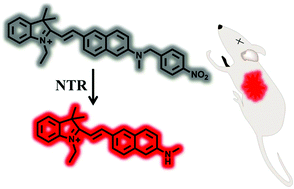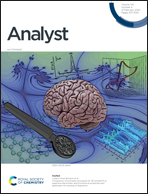A high-selectivity fluorescent probe for hypoxia imaging in cells and a tumor-bearing mouse model†
Abstract
Nitroreductase (NTR) with a high expression level in tumors has been considered as a biomarker of highly aggressive hypoxia tumors. Thus, it is important to develop powerful tools for tumor hypoxia detection. Here, we developed a two-photon fluorescent probe hTP-NNO2 for NTR detection. The probe with one-step synthesis exhibited high yield. hTP-NNO2 showed high selectivity and sensitivity for NTR and the detection limit was as low as 43 ng mL−1. hTP-NNO2 also showed low cytotoxicity and high stability, indicating that hTP-NNO2 is suitable for NTR detection in real-time and in situ under physiological conditions. hTP-NNO2 was used for NTR imaging in hypoxia cells and the fluorescence intensity of hTP-NNO2 increased with decreasing oxygen concentration. Benefiting from the advantages of two-photon fluorescent probes, we performed NTR detection in deep brain tissue with an imaging depth of up to 100 μm. hTP-NNO2 was further successfully applied for NTR detection in zebrafish and tumors. These results indicated that we developed a promising fluorescence imaging tool for NTR detection in vitro and in vivo.



 Please wait while we load your content...
Please wait while we load your content...